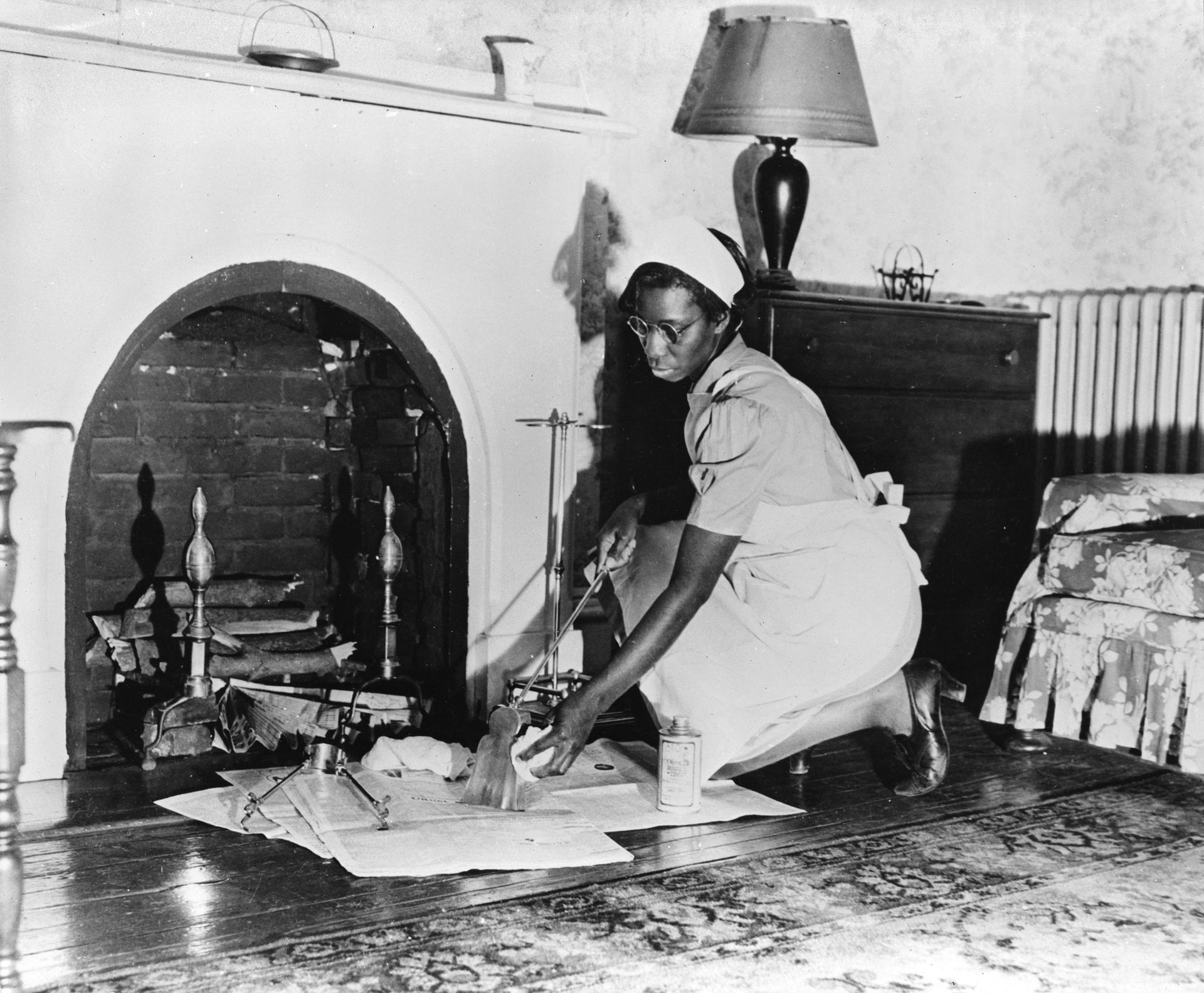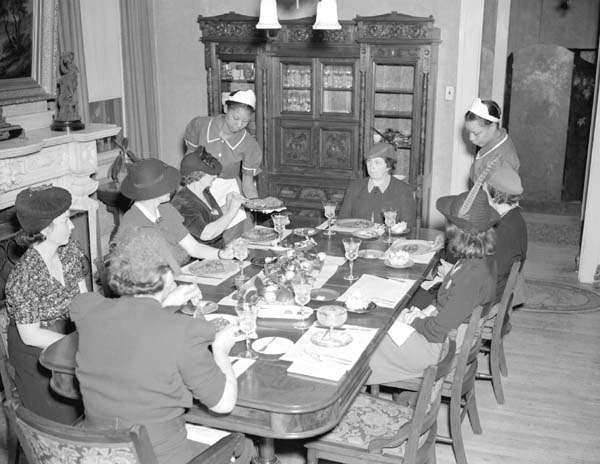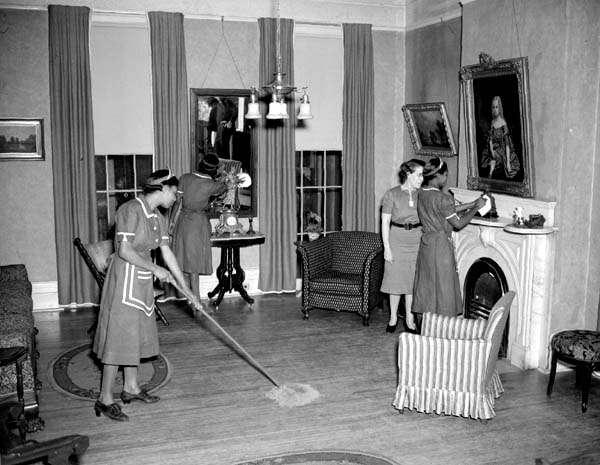Unsung black heroines launched a modern domestic workers movement — powered by their own stories
A WPA program in the 1930s trained African-American women to work as maids and household servants.
In the late 1990s, household workers around the country began to organize to address the exploitation and abuse they face.
These domestic workers, immigrant nannies, housecleaners and elder-care workers from all over the world — the Philippines, Barbados, Brazil, Mexico, El Salvador, Indonesia and Nepal — used public shaming strategies to draw attention to particularly egregious employers. They sued for back pay, developed support groups, organized training and certificate programs and lobbied for statewide domestic workers’ bills of rights.
In building a movement, domestic workers used storytelling to connect workers with one another. Barbara Young, for example, a former nanny and an organizer with the National Domestic Workers Alliance, joined Domestic Workers United in New York City in the early 2000s. Young was in a park one day with the child she cared for when another household worker, Erline Brown, invited her to a DWU meeting in Brooklyn.
“People were telling the stories about the work that they were doing, not getting vacation, not getting paid for holidays,” she explained. “It was the first time I was hearing stories from workers coming together.” DWU mobilized women of different racial, ethnic, linguistic, and national backgrounds.
Despite the diverse origins, all the stories seemed to resonate with one another. As Young put it: “Some people had different stories, but similar stories.”
This contemporary organizing is making its mark on today’s political landscape, but as a movement the struggle for domestic workers' rights started decades ago among private household workers, mostly African American women, who established a powerful nationwide movement to bring dignity, rights, and professionalization to their labor. One of their central goals was to revalue and upgrade the status of household labor. This distinguished them from many in the feminist community who denigrated housework in order to make a claim for employment opportunities outside the home.

Like contemporary organizers, they relied on storytelling to build political solidarity and recruit workers to their movement. Storytelling provided a means of transforming household labor: to critique the occupation, but also to imagine domestic work differently. The movement sought to change the character of domestic labor and to bring it recognition.
And it did so in multiple ways, including successfully lobbying for amendments to the Fair Labor Standards Act in 1974, which won household workers federal minimum wage protection after nearly forty years of exclusion. Meet three of the women who helped launch this movement:
Josephine Hulett: A working mother seeking advancement
Josephine Hulett was a single mother and household worker who formed the Youngstown Household Technicians in 1968. Two years later she became a field organizer for the National Committee on Household Employment, a middle-class organization that was interested in developing a network of domestic worker groups.
Hulett traveled around the country sharing her personal story with local organizations and encouraging them to participate in the first-ever national convention of household workers, which took place in 1971. Many household workers identified with the experiences Hulett shared of hardship, mistreatment, efforts at advancement and juggling work and single motherhood.
As a high school dropout with few job opportunities, Hulett turned to domestic work to support herself. Because she couldn’t afford paid child care, she left the baby with her ex-husband’s family during the day, and ventured out from her home in Girard, Ohio, near Youngstown, in search of day work. At her first job, she earned $25 a week for five and a half days. She paid eighty cents for bus fare, walking two and a half miles each way to avoid paying for an additional bus.
Her employer’s husband owned a produce company, yet she was given only a hot dog for lunch every day. She cared for four young children and cleaned a large house from top to bottom. Although she frequently worked late, she was never paid for overtime.
One day, when she left 30 minutes early to take her son to the doctor, her employer docked her pay. The next day she left at five o’clock and informed her boss she would never work overtime again. The following week, she was fired.

At her next job, Hulett accepted a meager salary of $22.50 a week, working for an elderly couple who had no small children living in the home. Despite the anticipated lighter workload, she cooked for the entire extended family on Friday nights and sometimes babysat grandchildren — all for no extra pay. When the family announced they were moving to Florida, they gave her no severance pay, no prior warning and no unemployment benefits.
Committed to improving her economic situation, Hulett studied part-time to earn her high school diploma. She then spent a year and a half and $285 — three months’ salary — taking a correspondence course to become a practical nurse. After completing it, she was shocked to learn that the course wasn’t accredited and she couldn’t practice in a medical facility.
Hoping to find work in the healthcare field, she looked for home-based nursing work — caring for an infant or an elderly or disabled person. Hulett encountered yet another obstacle, recalling, “I soon discovered that being a companion or baby nurse were jobs mostly for white women.”
She eventually found a job working for a young doctor, his wife, and their two babies, earning $35 a week for five days. In many ways it was a good position and a vast improvement from her previous jobs. She received wage increases, thoughtful gifts, paid vacations and sick leave. “They regarded me as a professional and an adult. They didn’t pretend that I was a ‘member of the family’ nor did they intrude on my life.”
Hulett’s story of her “good” employer also became important symbolically because it illustrated the possibility for just and respectable work and confirmed that there was nothing about the occupation that made it inescapably oppressive. Hulett’s story resonated with other black domestic workers.
She shared her struggles of living in the rural South and how her treatment on the job pegged her as separate and highly unequal. As a single mother, Hulett had to balance care for her son with full-time employment. She spent as much time with her son as she could and carved out one day a week to go out to lunch with him, “and that was an occasion he loved and looked forward to.”
As a black woman, she had few other job opportunities. And in those situations when she tried to assert her rights, she found herself unemployed. She was deeply concerned about the status and dignity of domestic workers and her treatment as a servant rather than a worker. “Even for a day worker, sometimes it seems the employer feels he or she owns you,” she said. “If you’re sick, some employers will call up the doctor to make sure you’re not lying.”

One morning at 4:30 a.m., Hulett saw an older black woman walking to work and offered her a ride. The woman had injured her hip while at work and had no sick leave or insurance. According to Hulett, her “employers refused to accept the fact that her injury had occurred while at work, and they refused to aid her in any way.”
Although she completed most of her work — sitting on a stool to wash dishes — she couldn’t take the child out for a walk. The employer, who was a stockbroker, hired a babysitter to do it for $2 a day and deducted the amount from the employee’s weekly wages. This woman’s story prompted Hulett to contact several other household workers and encouraged them to form the Youngstown Household Technicians in 1968. The sharing of stories and communal connection helped lay its foundation.
Geraldine Miller: Slaves no more
In 1935 investigative journalist Marvel Cooke and activist Ella Baker coauthored a widely circulated article about what they called the “slave market” of domestic labor. The article, published in the NAACP’s magazine, Crisis, cast light on an estimated 200 informal markets in New York City — essentially street corners — where African-American women waited in hopes of being hired for the day by white employers.
“Rain or shine, cold or hot, you will find them there — Negro women, old and young — sometimes bedraggled, sometimes neatly dressed … waiting expectantly for Bronx housewives to buy their strength and energy.”
Cooke and Baker highlighted the vulnerability of these workers: “Often, her day’s slavery is rewarded with a single dollar bill or whatever her unscrupulous employer pleases to pay. More often, the clock is set back for an hour or more. Too often she is sent away without any pay at all.”
Geraldine Miller was a worker leader who had never experienced the “slave markets” herself, nevertheless she used the stories she had heard to highlight the vulnerability of African American women in this occupation. The slave market stories also became a way to establish an agenda for reform. Miller used this story to establish boundaries for this labor and to assert that African American household workers would never again get down on their hands and knees to scrub floors.
.jpg&w=1920&q=75)
In 1954 Miller relocated to New York City, where she ended up doing mainly domestic work and living in the Bronx a short distance from the site of the most notorious “slave markets” of the Depression. She recounted hearing stories from women who stood on Burnside Avenue, waiting to be selected for cleaning jobs.
“Sometimes they’d ask to see your knees and the women with the worst-scarred knees were hired first because they looked like they worked the hardest.”
Hearing these stories was transformative for Miller: “This is just one of the things that kind of woke me up.”
In 1971, Miller was riding the train to work in suburban New York City when she struck up a conversation with a woman who began to talk about “fringe benefits” for household workers and informed her about the Urban League’s organizing efforts. The idea of better working conditions for household workers immediately caught Miller’s attention. “I wanted it, and I wanted it with a passion,” she said.
She attended a meeting of the Professional Household Workers Union, a New York City group initiated and led by Benjamin McLaurin of the Urban League, and learned about the work of the NCHE and the upcoming national conference of domestic workers. Miller arranged for league sponsorship of a bus for a group of workers to travel to the meeting in Washington, DC.
To recruit workers, she created a leaflet that read: “Stop, Look, and Listen. Become Aware of Your Rights as a Household Worker.”
She recalled, “I went out on street corners especially near the trains and I gave them out to all the people that rode on my train.”
Miller mobilized 33 women to attend the national conference. Although she had no prior political experience, after returning home from the conference, Miller formed the Bronx Household Technicians and the New York State Household Technicians, eventually becoming a prominent organizer and leader in the Household Technicians of America.
Carolyn Reed: Reclaiming humanity
Carolyn Reed, a household worker in New York, experienced the profound dehumanization associated with this labor, but also determined that establishing limits was absolutely essential.
When Reed took a live-in job for a wealthy family in Scarsdale, New York, she was welcomed as “one of the family.” That meant working from seven in the morning until midnight. In five years, Reed never received a raise, Social Security benefits, or a vacation.
“Then one night, the woman of the house — who had been having an affair and was very, very nervous — began to scream at me for not having done something she thought I should have done. … As she screamed I realized I wasn’t real to her. I mean, I wasn’t a person to her. … She had no respect for me, for what I did. … I was a servant to her, maybe even a slave. I remember while she was screaming I began saying ‘I don’t work for you any more.’ … And that was it. I packed my bags in the middle of the night; my husband, who was then my boyfriend, came and got me, and we took off.”

Reed devoted her afternoon break to organizing for the HTA. She entered the laundry rooms of apartment buildings: “The first rule of thumb is to get friendly with the doorman.”
Everyone in the neighborhood, not only the doormen, knew Reed. She also recruited at bus stops, service entrances, and neighborhood gourmet shops. Shopkeepers on Lexington Avenue regularly sent household workers her way. The Village Voice called her a “natural organizer at large.”
There were no clear geographical boundaries for household-worker organizing, especially as the workplace was often off-limits for outreach efforts. Reed firmly believed that household workers had power, which she suggested may take the form of a strike with the support of other service workers.
One reporter explained Reed’s position this way: “The idea of striking entire residential streets of Manhattan with delivery and repairmen honoring the picket lines doesn’t faze Reed in the least.”
Her sense of the potential to strike came from her view of the fundamentally indispensable labor power of household workers: “The houses could not be run. You could never know how helpless people can be — especially wealthy people — until you’ve worked in their homes. Just one day of true hardship or true inconvenience and they’d want to bargain.” Only through this kind of collective power, she argued, could wages be raised and working conditions improved. For Reed, “Housekeepers, mostly black women, are the last frontier of labor organizing.”
This is an adapted excerpt from "Household Workers Unite: The Untold Story of African American Women Who Built a Movement," by Premilla Nadasen (Beacon Press, 2016).
This story was originally published by YES! Magazine, a nonprofit publication that supports people’s active engagement in solving today’s social, political and environmental challenges.
The story you just read is accessible and free to all because thousands of listeners and readers contribute to our nonprofit newsroom. We go deep to bring you the human-centered international reporting that you know you can trust. To do this work and to do it well, we rely on the support of our listeners. If you appreciated our coverage this year, if there was a story that made you pause or a song that moved you, would you consider making a gift to sustain our work through 2024 and beyond?
